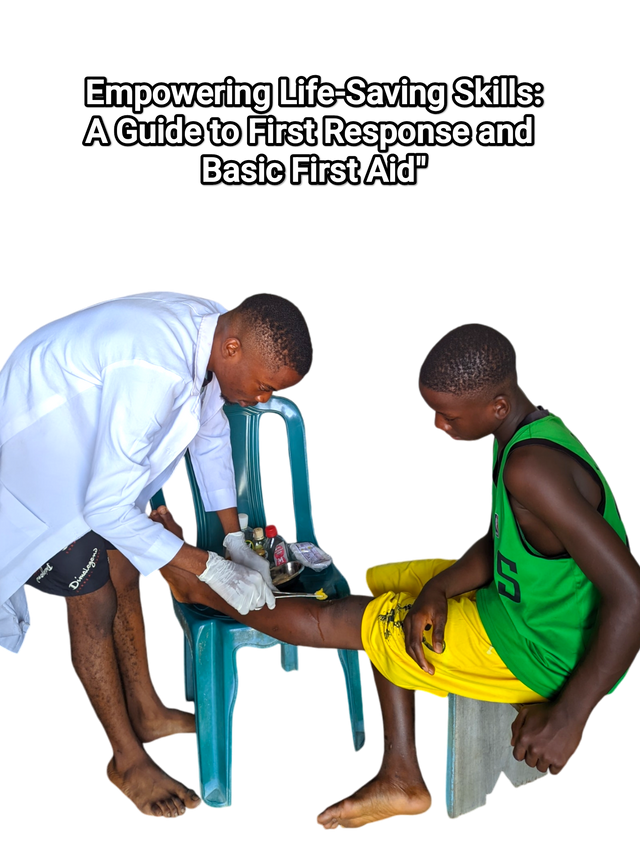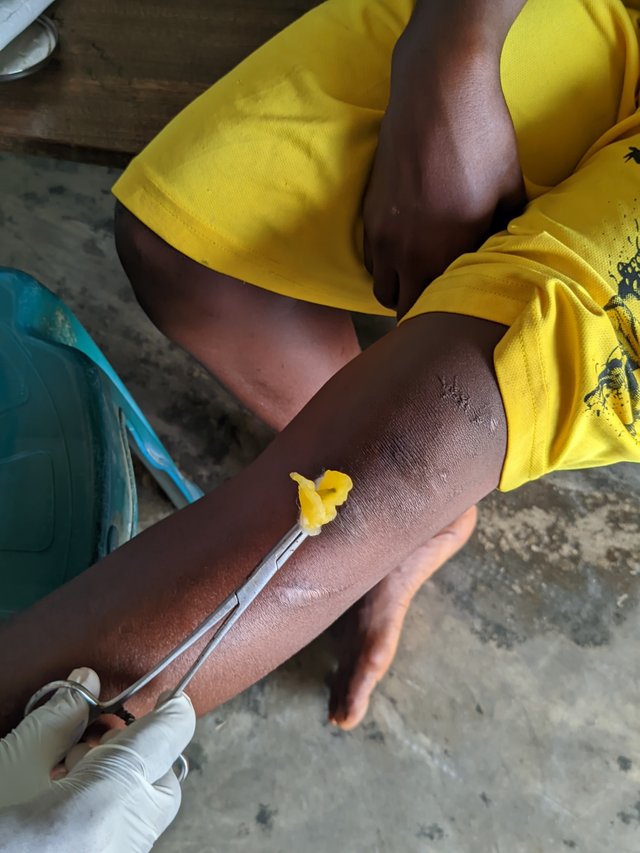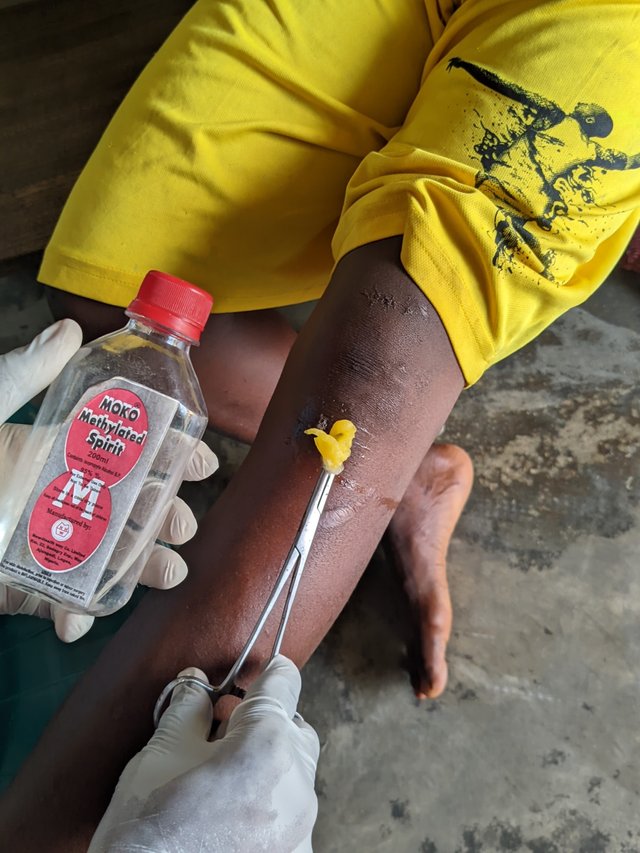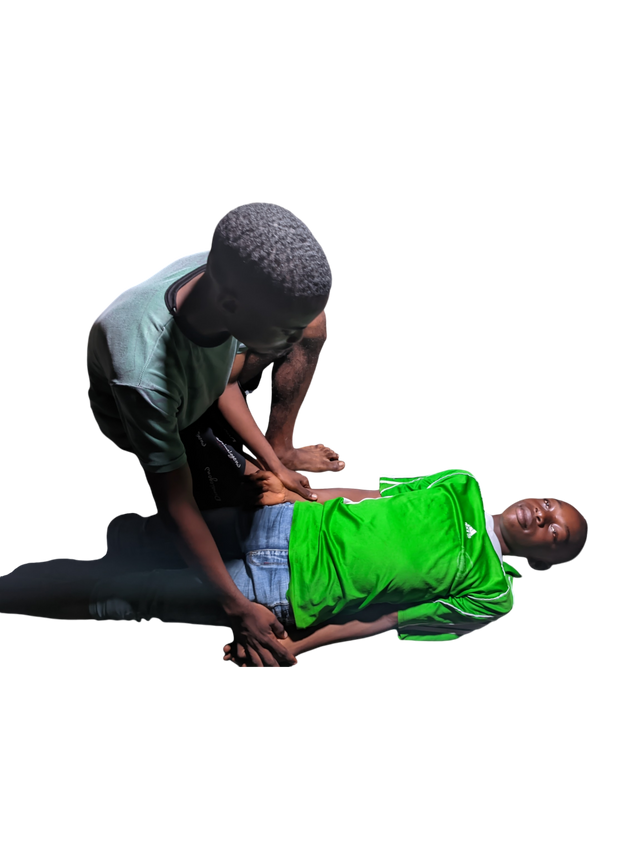
Edited using canva
Once upon a time on campus, a university student came out of a lecture hall and fell to the ground and started shaking continuously. Everyone ran and thought he was going to die. They didn't want to see the sight of blood. My friends and I were afraid because if you involve yourself now, you'll be taken for an explanation as an eyewitness.
I took courage and ensured there were no sharp objects on the floor where he was rolling. I tried staying calm and also told others it was just short-lived that he would recover. The shirt he wore was so tight. I reached out to him and tried removing the neck buttons while my friends helped me turn him to his side as I instructed them.
I kept his own bag on his head to support him and avoid hitting the head on the ground. We then stayed until he stopped convulsing. When he stopped, we had to rush him to the health centre because he wasn't conscious of where it was taken further from us.
This practice was what I saw my mom do when someone had a seizure in my neighborhood. I gave the guy first aid treatment before being taken to the clinic for further checks.. He later recovered after 20 minutes. He was lucky he didn't have this seizure on the main road. I felt empathy for him. That's when I knew you could save a person's life with first aid or first help. What am I trying to insinuate? My answering the following questions will give you a glimpse.
Share any experience of your life in which you faced an emergency that could be handled by yourself only if you know the basic first response skills. |
|---|
Ah, I just narrated an experience though, but I have lots of experiences relative to this. I can remember when I was still a novice in my mom's shop. A patient ran in with blood dripping on his legs. He said he had contact with a rusted nail, and he was in serious pain. The following pictures are not the real pictures but an exact representation of how the case was.
I didn't know what to do because my mom wasn't around and we were the only close medically inclined people in that area. I put a call across to my mother, but her phone wasn't going through. I was confused of what to do, as I've not done it before. This happened before the incident was narrated at the onset.

I couldn't just watch him bleed. I told him to sit on a chair and then suspended his leg on a chair as I brought out methylated spirit, which was the first thing I had in mind. I then thought of cleaning the wound first with savlon since he had put leaves inside the wound to stop the bleeding. I took a pair of gloves to protect contact with blood directly.

The gloves served as protection for my hands, as I would be holding his legs in the process of giving him first aid treatment. It also prevents tetanus transmission by touching it with bare hands.
 |  |
|---|

I used the antiseptic, wet in cotton wool, and tried cleaning the surface of the wound to remove the leaves, which can be infectious. After removing the leaves, I took methylated spirit dipped into cotton wool and brushed the surface of the wound, squeezing with the help of my mother's forceps.
 |  |
|---|
He felt the pain from the spirit's effect, but I calmed him down. With the aid of the spirit, I was able to stop the bleeding and then applied iodine to the coat, which I plastered with cotton wool so the liquid could drain in and heal him gradually. I told him to return back after 5 hours to meet my mum so he can tell him what he needs to do.
 |  |
|---|---|
 |  |
 | After dressing |
I also told him that he would have to inject tetanus injection since he was wounded by a rusted nail. That was how I helped him until he came later that evening and met my mom, who gave him further directives. Who knows what would have happened if I told him to continue waiting for my mom or go back? In the absence of methylated spirit and other first aid kits present in the box, how would I respond to that case.
I would do what we used to do when we were small. If we have injuries, we would wash it and press it with our hands till it stopped bleeding. I'll take the person to a relaxed position and try washing the wound with pure water if sold around. I'll then look for a clean cloth and tie the injured area to avoid further bleeding. Once this is ensured, I can now direct the person to get proper treatment, as it's one that involves tetanus prevention.
Imagine you are walking back home when you witness a road traffic accident between a car and a motorcycle, and the motorcycle is lying on the road, not moving. There’s some bleeding from his leg, and he appears to be unconscious. You being the first responder, how will you manage this scenario? (1.5 marks)
As the first person to respond to him, I'll try as much as possible not to ask as many questions as one can lose his life in the process of not acting fast. Seeing such a motorist on the floor unconscious, I'll teach out to him and take him to safety first and provide first aid treatment, as taking him to the hospital may be a long mile or kilometres away from where he lay. I need to ensure he's okay, and I can do this by assessing him physically.
- I'll first ensure the scene is cleared and people are not gathered. Since it's a road traffic accident, I'll alert passersby to signal incoming vehicles to slow down while the affected people are taken off the traffic.
- I'll then tell someone to arrange a vehicle for the motorcyclist to be taken to the nearest hospital, or better yet, I'll call one of the emergency numbers in my city for quick response service, dropping the location and nature of the accident, and also request for an ambulance to be brought.
- Before their arrival, I'll ensure I check his ability and respond as he lays unconsciously. I'll tap his shoulder with my hands gently or call him by his title to see if he'll respond or hear me. If he's unconscious, I'll check his airway and also watch his chest for movement of heartbeat to confirm he's breathing. I'll ensure his mouth remains open and not closed so as not to block or stop breathing, as this is one reason why an unconscious woman died.
- If he's breathing, I'll move to stopping the bleeding as people can bleed out to death. I'll try as much as possible to stop the bleeding by applying pressure to his legs or the affected area. I can tear a piece of my clothes to do so, maybe my shirt. I'll continue to monitor him for any changes. When the emergency individuals come, I'll hand over the affected person to them and also follow them to the hospital to see if he's okay or has some medical disorders as a result of where he or she hit.
I can remember a friend of mine who had an accident and was unconscious. She hit her head so badly that she was taken to the hospital and was on oxygen till she died. It was very painful and is still very painful till now. I wish such accidents didn't occur.
Draw or Create an engaging illustration/flowchart of DRABC protocol (Try to be creative and don't forget to add your username to the illustration) |
|---|
Before sharing my creativity on this, I'll love to explain what I understand by DRABC, as some may be confused with the acronym. Just as characteristics of living things have MR NiGER+CAD, first aid protocol has an acronym that defines what first aid is and how it should be done. It goes with the acronym DR ABC.
This DRABC is a first aid protocol that's structured in a way to guide first responders in an incident scene on what to do or the steps to carry out in assessing an injured or unconscious person.
The protocol serves as life-saving actions that will help stabilise a person that's injured or affected before help comes. Responders who follow these protocols would be indirectly saving that person's life and preventing the situation from worsening.
This structured protocol can be used or practiced in emergency situations on the road where accidents occur, at home, the workplace, or school. To use the DRABC, you need skills in treating shock and managing wounds until further care is given. These skills will help anyone using the protocol to effectively stabilise the accident victim before an emergency comes.
Not all schools teach how to do this, but a popular organisation called the Red Cross can help individuals learn how to practice these basic first aid treatments, including how their protocols can be observed. So you may be wondering what the full meaning of DRABC is.
D-Danger
This isn't meant to scare but is the first step in the first aid structured protocol. You need to observe the dangers you and the injured person may incur in that area. It could be that the accident is in traffic, and if care is not taken, another accident would happen. Just as explained before, you need to move the injured person out to safety where you can assess him with free mind. Move anything that may seem harmful to the injured person and yourself and try as much as possible to remove it.

R - Response
This is the second step, which involves checking if the person is conscious or responsive by tapping his shoulders to see if the person will move, or you can try calling the person. This is done by kneeling beside the person and calling out. Can you hear me? If the person is unconscious, immediate help would be needed but if they do, they should do as much as possible to keep them calm. That's where response comes in. You get to receive a response from the injured person to know if he's still alive or unconscious.

A - Airway is very important for breathing. If a person is unconscious, it would be best if you opened that person's mouth by moving the back slightly. This is to allow air to enter and to avoid saliva causing sticky throats as a result of prolonged closure of the mouth.

B - Breathing
This is done by placing your ear close to the person's mouth while looking to see if their chest beats. You listen for breath sounds to know if the person is still breathing. Cases like this usually involve oxygen, but you can start something as a first aider to endure breathing.

C - Circulation
This is the final step to check if there's severe bleeding or signs of shock, which can lead to death if not taken into consideration.

These are the protocols for DRABC first aid treatment. Sometimes it's challenging to carry out because of lack of knowledge or training, panic, and hazards in the environment.
Write down the numbers of emergency services of your country/area on a paper (Minimum 5, maximum 10) |
|---|
Since we are told to write down the numbers on a piece of paper, I don't see any need for further explanation, as the case may be. These are the emergency contacts in my area, Uyo City.

All these emergency numbers have roles to play just as you visit a hotel. There's a number for the restaurant different from that of the receptionist and dry cleaning services. Same with emergency contacts, as we have lots of emergencies, which could include fire, road accident, etc.
- Emergency contact for fire service ensures there's immediate response when there's a fire outbreak, and they try as much as possible to fight these fires, minimising damages and protecting lives.
- These numbers, especially for police assistance, allow individuals to report crimes, robberies, etc. and receive police immediate responses, whose duty it is to maintain law and order.
- The rescue team has an emergency number available for individuals to reach out to in traffic accidents or other accidents, as the case may be.
- We have a public health-related emergency number available for reach when there's a disease outbreak or public health emergencies.
They all have roles to play in ensuring emergencies are taken care of. First aid treatment exercise should be conducted weekly to create awareness that can help individuals know how to respond to emergency situations.

I invite @ahsansharif, @artist1111, @irawandedy
Student Name: @bossj23
Time of checking: Within 24 hours of the homework
Overall Grade: [8.5/10]
Plagiarism Check: Pass
AI Use: No
General Feedback:
You have demonstrated a solid grasp of first aid principles and emergency response procedures throughout your homework. Your narrative style is engaging and informative, effectively conveying the importance of these skills. I encourage you to continue refining your answers by incorporating specific details and visual aids to enhance clarity and impact. Keep up the excellent work!
Regards,
@abdu.navi03
Downvoting a post can decrease pending rewards and make it less visible. Common reasons:
Submit
I really appreciate the review. Thanks
Downvoting a post can decrease pending rewards and make it less visible. Common reasons:
Submit
https://x.com/bossj23Mod/status/1854724810472927562?t=qEF2l8kSx6od25ne15oTDQ&s=19
Downvoting a post can decrease pending rewards and make it less visible. Common reasons:
Submit